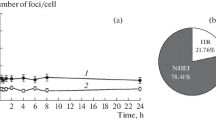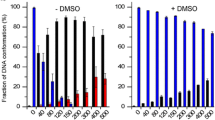Abstract
Inactivation of mammalian cells by ionizing radiation is caused by damage induced in the DNA (Marin and Bender 1963a,b; Burki and Okada 1970; Munro 1970). Among the various types of damage induced in DNA, double-strand breaks and probably also base damage are considered important, whereas single-strand breaks are much less relevant for cell killing (Ward 1985, 1986; Frankenberg-Schwager 1989). It is generally assumed that a certain portion of the primary lesions cannot be repaired and give rise to chromosomal aberrations that finally lead to cell death (Hopwood and Tolmach 1979).
Access this chapter
Tax calculation will be finalised at checkout
Purchases are for personal use only
Preview
Unable to display preview. Download preview PDF.
Similar content being viewed by others
References
Ahnström G, Edvardsson KA (1974) Radiation-induced single-strand breaks in DNA determined by rate of alkaline strand separation and hydroxylapatite chromatography: an alternative to velocity sedimentation. Int J Radiat Biol 26: 493–497
Barendsen GW (1982) Dose fractionation, dose rate and iso-effect relationships for normal tissue responses. Int J Radiat Oncol Biol Phys 8: 1981–1997
Ben-Hur E (1981) Enhanced radiation-induced killing of Chinese hamster cells by dideoxythymidine. Radiat Res 88: 155–164
Ben-Hur E, Elkind MM (1974) Thermally enhanced radioresponse of cultured Chinese hamster cells: damage and repair of single-stranded DNA and a DNA complex. Radiat Res 59: 484–495
Ben-Hur E, Elkind MM, Bronk BV (1974) Thermally enhanced radioresponse of cultured Chinese hamster cells: inhibition of repair of sublethal damage and enhancement of lethal damage. Radiat Res 58: 38–51
Blöcher D, Pohlit W (1982) DNA double-strand breaks in Ehrlich ascites tumour cells at low doses of X-rays. II. Can cell death be attributed to double strand breaks? Int J Radiat Biol 42: 329–338
Blöcher D, Nüsse M, Bryant PE (1983) Kinetics of double strand break repair in the DNA of X-irradiated synchronised mammalian cells. Int J Radiat Biol 43: 579–584
Bryant PE, Blöcher D (1980) Measurement of the kinetics of DNA double strand break repair in Ehrlich ascites tumour cells using the unwinding method. Int J Radiat Biol 38: 335–347
Bryant PE, Blöcher D (1982) The effect of 9–13-D-arabinofuranosyladenine on the repair of DNA strand breaks in X-irradiated Ehrlich ascites tumor cells. Int J Radiat Biol 42: 385–394
Burki HJ, Okada S (1970) Killing of cultured mammalian cells by radioactive decay of tritiated thymidine at —196°C. Radiat Res 41: 409–424
Clark EP, Dewey WC, Lett JT (1981) Recovery of CHO cells from hyperthermic potentiation to X-rays: repair of DNA and chromatin. Radiat Res 85: 302–313
Cole A, Shonka F, Corry P, Cooper WG (1975) CHO cell repair of single-strand and double-strand DNA breaks induced by y-and a-radiations. In: Hanawalt PC, Setlow RB (eds) Molecular mechanisms for repair of DNA, vol 5 B. Plenum Press, New York, pp 665–676
Collins A (1983) DNA repair in ultraviolet-irradiated HeLa cells is disrupted by aphidicolin, the inhibition of repair need not imply the absence of repair synthesis. Biochim Biophys Acta 741: 341–347
Coquerelle T, Bopp A, Kessler B, Hagen U (1973) Strand breaks and 5’end-groups in DNA of irradiated thymocytes. Int J Radiat Biol 24: 397–404
Cornforth MN, Bedford JS (1983) X-ray-induced breakage and rejoining of human interphase chromosomes. Science 222: 1141–1143
Corry PM, Robinson S, Getz S (1977) Hyperthermic effects on DNA repair mechanisms. Radiology 123: 475–482
Dikomey E (1982) Effect of hyperthermia at 42 and 45 °C on repair of radiation-induced DNA strand breaks in CHO cells. Int J Radiat Biol 41: 603–614
Dikomey E (1990) Induction and repair of DNA strand breaks in X-irradiated proliferating and quiescent CHO cells. Int J Radiat Biol 57: 1169–1182
Dikomey E, Flentje M (1993) Repair kinetics of X-ray-induced DNA strand breaks measured by the alkaline unwinding and the neutral elution technique: a comparative study. Int J Radiat Biol (submitted)
Dikomey E, Franzke J (1986) Three classes of DNA strand breaks induced by X-irradiation and internal beta-rays. Int J Radiat Biol 50: 893–908
Dikomey E, Franzke J (1988) DNA denaturation kinetics in CHO cells exposed to different X-ray doses and after different repair intervals using the alkaline unwinding technique. Radiat Environ Biophys 27: 29–37
Dikomey E, Franzke J (1992) Effect of heat on induction and repair of DNA strand breaks in X-irradiated CHO cells. Int J Radiat Biol 61: 221–234
Dikomey E, Jung H (1991) Thermal radiosensitization in CHO cells by prior heating at 41–46°C. Int J Radiat Biol 59: 815–825
Dikomey E, Jung H (1993) Correlation between thermal radiosensitization and reduction of DNA polymerase 13 activity in CHO cells. Int J Radiat Biol (in press)
Dikomey E, Lorenzen J (1993) Repair of DNA strand breaks in CHO cells exposed to X-ray doses from 3 to 90Gy. Int J Radiat Biol (submitted)
Dikomey E, Becker W, Wielckens K (1987) Reduction of DNA-polymerase ß activity of CHO cells by single and combined heat treatments. Int J Radiat Biol 52:775–785
Dube DK, Seal G, Loeb LA (1977) Differential heat sensitivity of mammalian DNA polymerases. Biochem Biophys Res Commun 76: 483–487
Edenberg HJ, Anderson, S, DePamphilis ML (1978) Involvement of DNA polymerases a in Simian virus 40 DNA replication. J Biol Chem 253: 3273–3280
Föhe C (1991) Erzeugung and Reparatur von “Endonuclease-sensitiven Läsionen” in Röntgenbestrahlten CHO-Zellen. PhD Thesis, University of Hamburg
Francis AA, Snyder RD, Dunn WC, Regan JD (1981) Classification of chemical agents as to their ability to induce long-or short-patch DNA repair in human cells. Mutat Res 83: 159–169
Frankenberg-Schwager M (1989) Review of repair kinetics for DNA damage induced in eukaryotic cells in vitro by ionizing radiation. Radiother Oncol 14:307–320
Fry M, Loeb LA (1986) Animal cell DNA polymerases. CRC Press.
Boca Raton Hagen U (1973) Strahlenwirkung auf Struktur and Funktion der Desoxyribonukleinsäure. Biophysik 9: 279–289
Hopwood LE, Tolmach LJ (1979) Manifestations of damage from ionizing radiation in mammalian cells in postirradiation generations. In: Lett JT, Adler H (eds) Advances in Radiation Biology, vol 8. Academic Press, New York, pp 317–362
Hutchinson F (1989) On the measurement of DNA double-strand breaks by neutral elution. Radiat Res 120: 182–186
Iliakis G, Pantelias GE, Seaner R (1988) Effect of arabinofuranosyladenine on radiation-induced chromosome damage in plateau-phase CHO cells measured by premature chromosome condensation: implications for repair and fixation of a-PLD. Radiat Res 114: 361–378
Iliakis G, Seaner R, Okayasu R (1990) Effects of hyperthermia on the repair of radiation-induced DNA single-and double-strand breaks in DNA double-strand break repair-deficient and repair-proficient cell lines. Int J Hyperthermia 6: 813–833
Johnson RT, Collins ARS, Waldren CA (1982) Prematurely condensed chromosomes and the analysis of DNA and chromosome lesions. In: Rao PN, Johnson RT, Sperling K (eds) Premature chromosome condensation. Academic Press, New York, pp 253–308
Jorritsma JBM, Konings AWT (1983) Inhibition of repair of radiation-induced strand breaks by hyperthermia, and its relationship to cell survival after hyperthermia alone. Int J Radiat Biol 43: 505–516
Jorritsma JBM, Burgman P, Kampinga HH, Konings AWT (1986) DNA polymerase activity in heat killing and hyperthermic radiosensitization of mammalian cells as observed after fractionated heat treatments. Radiat Res 105: 307–319
Kow YW, Faundez G, Melamede RJ, Wallace SS (1991) Processing of model single-strand breaks in oX-174 RF transfecting DNA by Escherichia coli. Radiat Res 126: 357–366
Lunec J, Hesslewood IP, Parker R, Leaper S (1981) Hperthermic enhancement of radiation cell killing in He La S3 cells and its effect on the production and repair of DNA strand breaks. Radiat Res 85: 116–125
Marin G, Bender MA (1963a) Survival kinetics of He La S-3 cells after incorporation of 3H-thymidine or 3H-uridine. Int J Radiat Biol 7: 221–223
Marin G, Bender MA (1963b) A comparison of mammalian cell-killing by incorporated 3H-thymidine or 3H-uridine. Int J Radiat Biol 7: 235–244
Matsudaira H, Furuno I, Ueno AM, Shinohara K, Yoshizawa K (1977) Induction and repair of strand breaks and 3’-hydroxy terminals in the DNA of mammalian cells in culture following y-ray irradiation. Biochim Biophys Acta 476: 97–107
McGhie JB, Wold E, Pettersen EO, Moan J (1983) Combined electron radiation and hyperthermia. Repair of DNA strand breaks in NHIK 3025 cells irradiated and incubated at 37, 42.5, or 45 °C. Radiat Res 96: 31–40
Mills MD, Meyn RE (1981) Effects of hyperthermia on repair of radiation-induced DNA strand breaks. Radiat Res 87: 314–328
Munro TR (1970) The relative radiosensitivity of the nucleus and cytoplasm of Chinese hamster fibroblasts. Radiat Res 42: 451–470
Nelson SJ (1982) Models for DNA damage formation and repair in mammalian cells exposed to ionizing irradiation. Radiat Res 42: 451–470
Okayasu R, Iliakis G (1989) Linear DNA elution dose response curves obtained in CHO cells with non-unwinding filter elution after appropriate selection of the lysis conditions. Int J Radiat Biol 55: 569–581
Peak MJ, Peak JG, Blazek ER (1988) Symposium report. Radiation-induced DNA damage and repair: Argonne National Laboratory Symposium, Argonne, Illinois 60439, 15 April, 1988. Int J Radiat Biol 54: 513–519
Radford IR (1983) Effects of hyperthermia on the repair of X-ray-induced DNA double strand breaks in mouse L cells. Int J Radiat Biol 43: 551–557
Resnick MA (1976) The repair of double-strand breaks in DNA: a model involving recombination. J Theor Biol 59: 97–106
Roti Roti JL, Winward RT (1980) Factors affecting the heat-induced increase in protein content of chromatin. Radiat Res 81: 138–144
Rowley R, Kort L (1988) The effect of modulators of radiation-induced G2 arrest on the repair of radiation-induced DNA damage detectable by neutral filter elution. Int J Radiat Biol 54: 749–759
Rydberg B (1975) The rate of strand separation in alkali of DNA of irradiated mammalian cells. Radiat Res 61: 274–287
Rydberg B (1980) Detection of induced DNA strand breaks with improved sensitivity in human cells. Radiat Res 81: 492–495
Spiro IJ, Denman DL, Dewey WC (1982) Effect of hyperthermia on CHO DNA polymerase a and ß. Radiat Res 89: 134–149
van der Schans GP, Paterson MC, Cross WG (1983) DNA strand break and rejoining in cultured human fibroblasts exposed to fast neutrons or gamma rays. Int J Radiat Biol 44: 75–85
Ward JF (1985) Biochemistry of DNA lesions. Radiat Res 104: 103–111
Ward JF (1986) Mechanisms of DNA repair and their potential modification for radiotherapy. Int J Radiat Oncol Biol Phys 12: 1027–1032
Ward JF, Limoli CL, Calabro-Jones PM, Aguilera J (1991) An examination of the repair saturation hypothesis for describing shouldered survival curves. Radiat Res 127: 90–96
Warters RL, Roti Roti JL (1978) Production and excision of 5’,6’-dihydr txydihydrothymine type products in the DNA of preheated cells. Int J Radiat Biol 34: 381–384
Warters RL, Lyons BW, Axtell-Bartlett J (1987) Inhibition of repair of radiation-induced DNA damage by thermal shock in Chinese hamster ovary cells. Int J Radiat Biol 51: 505–517
Weibezahn KF, Coquerelle T (1981) Radiation induced DNA double-strand breaks are rejoined by ligation and recombination processes. Nuc1 Acids Res 9: 3139–3150
Wlodek D, Hittelman WN (1988) The relationship of DNA and chromosome damage to survival of synchronized X-irradiated L51787 cells. II. repair. Radiat Res 115: 566–5750
Author information
Authors and Affiliations
Editor information
Editors and Affiliations
Rights and permissions
Copyright information
© 1994 Springer-Verlag Berlin Heidelberg
About this chapter
Cite this chapter
Dikomey, E. (1994). Mechanisms of Thermal Radiosensitization Studied in CHO Cells. In: Obe, G. (eds) Advances in Mutagenesis Research. Advances in Mutagenesis Research, vol 5. Springer, Berlin, Heidelberg. https://doi.org/10.1007/978-3-642-78193-3_2
Download citation
DOI: https://doi.org/10.1007/978-3-642-78193-3_2
Publisher Name: Springer, Berlin, Heidelberg
Print ISBN: 978-3-642-78195-7
Online ISBN: 978-3-642-78193-3
eBook Packages: Springer Book Archive




